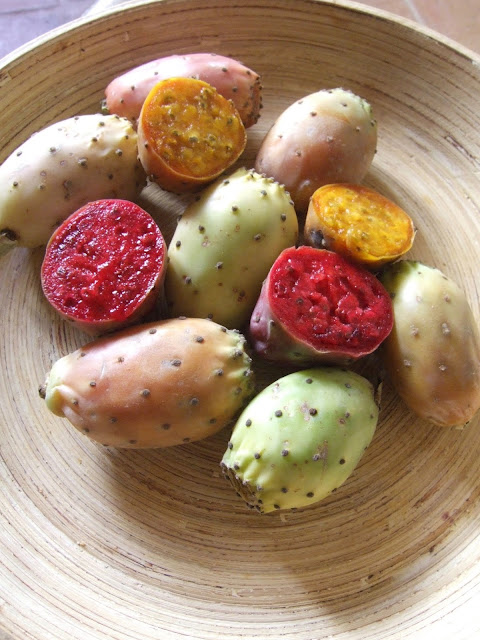Figos da Índia Portugueses,uma fruta cheia de benefícios
The
fig tree, Opuntia ficus-indica, was brought from America to
Europe at the time of the voyages of discovery, having adapted itself to where the
weather conditions were more favourable.In Portugal, it was mainly in the Algarve and Alentejo.
It is also known as piteira, devil-fig, tabaio or tabaibo or Barbary fig, more commonly the prickly pear.The cultivation of the Indian fig tree in Portugal is only as recent as 2010. Up until then it had appeared wild, on the borders of rural roads and farmland. The only way the fruit was collected was by individuals foraging it.In recent years, orchard plantations have begun to appear throughout most of the country, a professional association has been formed, a cooperative of growers,and new uses have been found, as a result processed products have emerged.
Events
(fairs, seminars, workshops) have begun to take place.These fruits are virtually unknown and have a limited consumption,something we consider to be a niche market.If growers are going to make a sustainable living by their product it has to have a broader market.There is a growing market for"exotic products", particularly those with organic certification.This is a market which attracts a range of customers, like myself, looking for new,rare and unfamiliar things.
The market for fresh harvested figs as an exotic food item will always be limited.However it is not just the fruit but the entire Indian fig tree that has wider uses than just being part of the food in our shopping trolley.
The marketing of further applications will support the sustainable farming of this plant.The seeds can be used in the production of oil for cosmetic products and is one of the most sought after oils in the world.The fibre of the Indian fig when dried can be applied to furniture and fashion accessories.The flowers when dried can be used in many infusions with remedial properties and to improve bodily functions.Studies demonstrate positive results pharmaceutically in the treatment and healing processes of cancer psoriasis,eczema,muscle pain,inflammation of the respiratory and digestive tracts,blood pressure, liver,diabetes,atherosclerosis and ulcers.
The young cladodes or flattened leaf like stems are usually considered to be modified branches, and can be used in vinaigrettes for salads, for animal fodder and in processed fruit products.
It is also known as piteira, devil-fig, tabaio or tabaibo or Barbary fig, more commonly the prickly pear.The cultivation of the Indian fig tree in Portugal is only as recent as 2010. Up until then it had appeared wild, on the borders of rural roads and farmland. The only way the fruit was collected was by individuals foraging it.In recent years, orchard plantations have begun to appear throughout most of the country, a professional association has been formed, a cooperative of growers,and new uses have been found, as a result processed products have emerged.
Nelson Ventura,manager,Confraria do Figo da Índia at a recent tasting in Supermercado Intermarche,Vila Real de Santo Antonio,uma parceria entre a Confraria do figo da india e a empresa Pepe Aromas
The market for fresh harvested figs as an exotic food item will always be limited.However it is not just the fruit but the entire Indian fig tree that has wider uses than just being part of the food in our shopping trolley.
The marketing of further applications will support the sustainable farming of this plant.The seeds can be used in the production of oil for cosmetic products and is one of the most sought after oils in the world.The fibre of the Indian fig when dried can be applied to furniture and fashion accessories.The flowers when dried can be used in many infusions with remedial properties and to improve bodily functions.Studies demonstrate positive results pharmaceutically in the treatment and healing processes of cancer psoriasis,eczema,muscle pain,inflammation of the respiratory and digestive tracts,blood pressure, liver,diabetes,atherosclerosis and ulcers.
The young cladodes or flattened leaf like stems are usually considered to be modified branches, and can be used in vinaigrettes for salads, for animal fodder and in processed fruit products.
Harvesting may be a challenge, but growing them is definitely not. They
easily reproduce by seed and also by stem fragments detaching and
rooting to form new plants. No wonder these plants have now naturalised
across Portugal. This might be great for anyone who enjoys making jam, jellies, juice, licores or dressings.Judging by the response I have been getting from our guests here at Casa Rosada, this fig is going to become part of the breakfast table.If we all adopt this fruit in our diets then we can enable an increase in demand and production, resulting in Portugal being able to join other countries exporting the fruit globally.I am sure this could be a breakthrough product in some of the UK supermarkets ,but we must be be quick or Brexit will get in the way.
For a prickly pear mojito and other adaptable recipes click here.





Artigo muito completo.
ReplyDeleteObrigado pelo interesse e divulgação do Figo da india!
Nelson Ventura